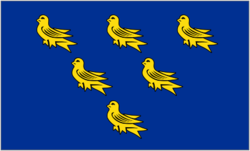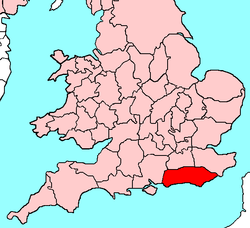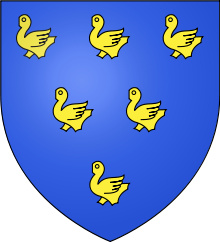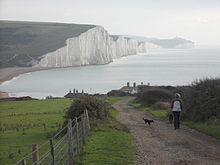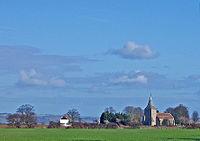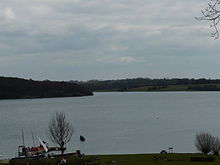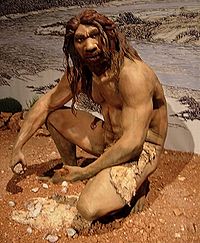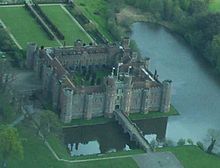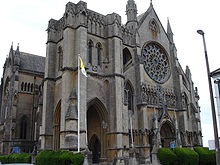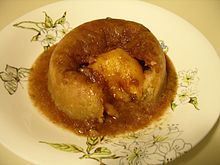- Sussex
-
"County of Sussex" redirects here. For other uses, see Sussex County (disambiguation).This refers to the historic county in England. For other uses either see Sussex (disambiguation) or, for the administrative counties that Sussex is divided into, East Sussex and West Sussex.
Sussex Motto: We wunt be druv
Flag of Sussex
Ancient extent of SussexGeography Status Ceremonial county (until 1974) 1831 area 907,920 acres (3,674 km2)[1] 1901 area 932,409 acres (3,773 km2)[1] 1991 area 934,900 acres (3,783 km2)[1] HQ Chichester or Lewes Chapman code SSX History Origin Kingdom of Sussex Created In antiquity Succeeded by East Sussex and West Sussex Demography 1831 population
- 1831 density272,340[1]
0.3/acre1901 population
- 1901 density602,255[1]
0.6/acre1991 population
- 1991 density1,392,737[1]
1.5/acreSubdivisions Type Rapes Sussex (
 /ˈsʌsɨks/; abbreviated Sx[2]), from the Old English Sūþsēaxe ('South Saxons'), is an historic county in South East England corresponding roughly in area to the ancient Kingdom of Sussex. It is bounded on the north by Surrey, east by Kent, south by the English Channel, and west by Hampshire, and is divided for local government into West Sussex and East Sussex and the city of Brighton and Hove. The city of Brighton & Hove was created a unitary authority in 1997; and was granted City status in 2000. Until then Chichester had been Sussex's only city.
/ˈsʌsɨks/; abbreviated Sx[2]), from the Old English Sūþsēaxe ('South Saxons'), is an historic county in South East England corresponding roughly in area to the ancient Kingdom of Sussex. It is bounded on the north by Surrey, east by Kent, south by the English Channel, and west by Hampshire, and is divided for local government into West Sussex and East Sussex and the city of Brighton and Hove. The city of Brighton & Hove was created a unitary authority in 1997; and was granted City status in 2000. Until then Chichester had been Sussex's only city.Sussex has three main geographic sub-regions, each orientated approximately east to west. In the south-west of the county lies the fertile and densely-populated coastal plain. North of this lies the rolling chalk hills of the South Downs, beyond which lies the well-wooded Sussex Weald.
The name 'Sussex' derives from the Kingdom of Sussex, founded by Ælle of Sussex in 477AD, which in 825 was absorbed into the kingdom of Wessex and the later kingdom of England. The region's roots go back further to the location of some of Europe's earliest hominid finds at Boxgrove. Sussex has been a key location for England's major invasions, including the Roman invasion of Britain and the Battle of Hastings.
The appellation Sussex remained in use as a ceremonial county until 1974, when the Lord-Lieutenant of Sussex was replaced with one each for East and West Sussex. The whole of Sussex has had a single police force since 1968.
Contents
Symbols
The flag of Sussex consists of six gold martlets on a blue background. Officially recognised by the Flag Institute on 20 May 2011, its design is based on the coat of arms of Sussex which first appeared in an atlas by John Speed in 1622. The significance of the six martlets may be to represent the traditional six sub-divisions of the county known as rapes.
Sussex by the Sea is regarded as the unofficial anthem of Sussex, composed by William Ward-Higgs in 1907, perhaps originally from the lyrics of Rudyard Kipling's poem entitled Sussex. Adopted by the Royal Sussex Regiment and popularised in World War I, it is sung at celebrations across the county including those at Lewes Bonfire and at sports matches, including those of Brighton and Hove Albion Football Club and Sussex County Cricket Club.
The county day, called Sussex Day, is celebrated on 16 June, the same day as the feast day of St Richard of Chichester, Sussex's patron saint, whose shrine at Chichester Cathedral was an important place of pilgramage in the Middle Ages.
Sussex's motto, We wunt be druv, is a Sussex dialect expression meaning 'we will not be pushed around' and reflects the traditionally independent nature of Sussex men and women. The round-headed rampion, also known as the 'Pride of Sussex', was adopted as Sussex's county flower in 2002.
Geography
Relief
The physical geography of Sussex relies heavily on its lying on the southern part of the Wealden anticline. The major features of that are the high lands which cross the county in a west to east direction: the Weald itself, and the South Downs. The former consists of clays and sands; the latter chalk. Between those two ridges, mainly in West Sussex, lies the "Vale of Sussex"; at the eastern end of the county is the valley of the River Rother, which flows into what was a long sea inlet to reach the sea at Rye Bay.
The Weald
The Weald is what remains of the vast forest that existed between the North and South Downs. It can be split into three parts, the High Weald, the Low Weald and the Greensand Ridge. The High Weald runs in an easterly direction from St Leonard's Forest, south-west of Crawley, and continues to Ashdown Forest. Its eastern extremity is in two sections, divided by the River Rother valley. The northern arm reaches the sea at Folkestone (in Kent); the southern at Fairlight Down east of Hastings.
Within the Weald lies Sussex's highest point, the pine-clad Black Down, close to the Surrey border at 280 metres (919 feet).[3] Another high point is in the part called Forest Ridges: a height of 242 metres (794 ft) is reached at Beacon Hill [4] in the neighbourhood of Crowborough.
The Weald gets its name from the Old English weald, meaning "forest". The High Weald has the greatest amount of ancient woodland in any AONB, representing 7% of all the ancient woodland in England.[5] Around 1660 the total area under forest was estimated to exceed 200,000 acres (81,000 ha), and charcoal from the woodlands supplied the furnaces and forges of the ironworks which formed an important industry in the county until the 17th century, and which survived even until the early years of the 19th century.
South Downs
The South Downs start from a point near Petersfield in Hampshire. On entering Sussex, their summit is about 10 miles (16 km) from the sea. They run east for some 50 miles (80 km), gradually approaching the coast, and terminating in the bold promontory of Beachy Head near Eastbourne. Their average height is about 152 metres (499 ft) though Ditchling Beacon is 248 metres (814 ft) [4] (the third highest summit) and many other summits exceed 212 metres (696 ft).
Vale of Sussex
The Vale of Sussex is the lower undulating land which came into being when the softer clays between the Weald and the Downs were worn away. Crossing the Vale are most of the rivers in Sussex: those rising on the slopes of the Weald and cutting through the Downs to reach the sea (see Drainage).
Coastal plain
This is a fertile narrow belt from Chichester to Brighton. Once noted for market gardening, it is now heavily built up into a sprawling coastal conurbation. The beaches along the coast vary from sandy to shingle: that factor, together with the mild climate of the coast, sheltered by the hills from north and east winds, has resulted in the growth of numerous resort towns, of which the most popular are (east to west) Brighton, Shoreham-by-Sea, Worthing, Littlehampton and Bognor Regis.
Marshland
There are several areas of low-lying marshland along the coast; from west to east these are:
- in the west of the county, south of Chichester, between Chichester Harbour and Pagham Harbour;
- beyond Beachy Head, the "Pevensey Levels";
- beyond Hastings, the "Pett Levels";
- beyond Rye, the "Walland Marsh" part of Romney Marsh.
All were originally bays; natural coastal deposition and man-made protective walls have given rise to alluvial deposition.
Hydrography
Sussex has rivers that flow into both the English Channel and the Thames Estuary of the North Sea. Flowing to the English Channel are the Arun, Adur, Ouse, Cuckmere and Rother. Flowing to the Thames Estuary and the North Sea are the Mole and Medway. At 113 kilometres (70 mi) long, the River Medway is the longest river flowing through Sussex. The longest river entirely in Sussex is the River Arun, which is 41 kilometres (25 mi) long.
The rivers wholly within the county are relatively short. All Sussex's rivers rise in the Weald, with the Arun, the western branch of the Adur, the Mole and the Ouse all rising in the area of St Leonard's Forest. Most of the county's rivers flow either southwards or northwards. Exceptions are the western River Rother and the eastern River Rother which each flow in an easterly direction. Many of the county's rivers are supplemented by winterbournes which in particular rise in the chalk of the South Downs. Some of the rivers flowing to the English Channel use gaps in the South Downs to do so. The mouths of all have been affected by longshore drift, particularly during violent storms during the Middle Ages.
Rivers wholly within Sussex from west to east are:
- Lavant - called a river but really a winterbourne, flowing from East Dean to Chichester Harbour
- Arun, and its tributary the western River Rother: source of Arun near Horsham; entering the sea at Littlehampton
- Adur: source near Cuckfield; mouth near Shoreham-by-Sea
- Ouse: source near Lower Beeding; mouth at Newhaven
- Cuckmere: rising near Heathfield; mouth Cuckmere Haven between Eastbourne and Seaford
- Eastern River Rother and its many tributaries including the Rivers Brede and Tillingham; source, Rotherfield in the High Weald and enters the sea at Rye Bay. A section known as the Kent Ditch forms part of Sussex's eastern boundary with Kent.
Sussex's largest lakes are man-made reservoirs. The largest is Bewl Water on the Kent border, while the largest wholly within Sussex is Ardingly Reservoir.
Marine environment
Sussex's offshore environment includes such varied features as the Shoal of the Lead 8km south of Selsey Bill where the seabed dramatically plunges from 0 to 67 metres causing strong underwater cascades, a feature which may be unique to the British Isles.[6] There are sandstone reefs and caves, and also some of Europe's finest chalk reefs.[7]
Climate
South East England combines the highest average daytime temperatures found in the British Isles with the highest sunshine averages on the British mainland. Rainfall is heaviest on the South Downs with 950 mm (37 in) of rainfall. Periods of high rainfall can lead to localised flooding; dry spells can lead to water restrictions. As Southern England is closest to the Continent of Europe, this can result in cold spells in winter and hot, humid weather in summer.[8]
The climate of the coastal districts is strongly influenced by the sea, which, because of its tendency to warm up slower than land, can result in cooler temperatures than inland in the summer. In the autumn months, the coast sometimes has higher temperatures. Rainfall during the summer months is mainly from thunderstorms and thundery showers; from January to March the heavier rainfall is due to prevailing south-westerly frontal systems. The coast has consistently more sunshine than the inland areas: sea breezes, blowing off the sea, tend to clear any cloud from the coast. However, in winter the east winds can be as cold as further inland.[8]
Industries
Agriculture
Sussex has retained much of its rural nature: apart from the coastal strip, it has few large towns. Although in 1841 over 40% of the population were employed in agriculture (including fishing), today less than 2% are so employed. The wide range of soil types in the county leads to great variations in the patterns of farming. The Wealden parts are mostly wet sticky clays or drought-prone acid sands and often broken up into to small irregular fields and woods by the topography, making it unsuitable for intensive arable farming. Pastoral or mixed farming has always been the pattern here, with field boundaries often little changed since the medieval period. Sussex cattle are the descendants of the draught oxen which continued to be used in the Weald longer than in other parts of England. Agriculturalist Arthur Young commented in the early 18th century that the cattle of the Weald "must be unquestionably ranked among the best of the kingdom."[9] William Cobbett, riding through Ashdown Forest, said he had seen some of the finest cattle in the country on some of the poorest farms. Areas of cereals grown on the Weald have risen and declined with the price of grain. The chalk downlands were traditionally grazed by large numbers of small Southdown sheep, suited to the low fertility of the pasture, until the coming of artificial fertiliser made cereal growing worthwhile. Yields are still limited by the alkalinity of the soil. Apart from a few areas of alluvial loam soil in the river valleys, the best and most intensively farmed soils are on the coastal plain, where large-scale vegetable growing is commonplace. Glasshouse production is also concentrated along the coast where hours of sunshine are greater than inland.
There are still fishing fleets, notably at Rye and Hastings, but the number of boats is much reduced. Historically, the fisheries were of great importance, including cod, herring, mackerel, sprats, plaice, sole, turbot, shrimps, crabs, lobsters, oysters, mussels, cockles, whelks and periwinkles. Bede records that St Wilfrid, when he visited the county in 681, taught the people the art of net-fishing. At the time of the Domesday survey the fisheries were extensive, and no fewer than 285 salinae (saltworks) existed. The customs of the Brighton fishermen were documented in 1579.
There are working harbours at Rye, Hastings, Newhaven and Shoreham; whilst Pagham and Chichester harbours cater for leisure craft, as does Brighton Marina.
Iron working
Deposits of ironstone which occur where sandstone strata overlie weald clay have been exploited from early in the Iron Age. The Romans made full use of this resource, and iron slag was widely used as paving material on the Roman roads of the area.[10] In medieval times the Weald was of national importance in the iron industry,[11] with numerous streams dammed to create furnace ponds, where water-powered bellows drove blast furnaces, and hammer ponds where wrought iron was hammered out of the raw iron from the furnaces. This made the area strategically important for producing iron cannon during the English Civil War, when the Yalding family of ironmasters at Fernhurst had a policy of armed neutrality, firing on soldiers from either side who tried to enter the parish.
Clay working (pottery, tiles, bricks)
As much of the Mid Sussex area has clay not far under the surface, clay has in the past been a focus of industry in central Sussex, in particular in the Burgess Hill area. In the first quarter of the 20th century, Burgess Hill and the Hassocks and Hurstpierpoint areas had many kilns, clay pits and similar infrastructure to support the clay industry: nowadays the majority of this form of industry has left the area, although it still can be seen in place names such as "Meeds Road", "The Kiln", or Oakmeeds Community College, which is named after the oak trees in the area and Meeds Pottery, a once significant pottery in the centre of Burgess Hill. At the height of the success of this industry, tiles and bricks from Sussex were used to build landmarks such as Manchester's G-Mex, but now there is just one main tileworks in the area, Keymer Tileworks. Plans have been submitted to develop the area into housing, so even this tileworks now has a closing date.
Service industries
The string of holiday resorts, and the many tourist attractions, form part of the main economic base in Sussex. The University of Sussex and the University of Brighton provide employment for many more, whilst reasonable rail connections allow many people to work in London.
Borough English
The custom of borough-English, by which land descends to the youngest son, prevailed to an extraordinary degree in Sussex, and 140 manors have been catalogued in which it was found. Gavelkind tenure existed in Rye, in the large manor of Brede, and in Coustard manor (in Brede parish).
Population
The area of the ancient county is 933,887 acres (377,931 ha) with a population in 1891 of 550,446 and in 1901 of 605,202. The earliest statement as to the population is made by Bede, who describes the county as containing in 681 land of 7,000 families; allowing ten to a family (a reasonable estimate at that date), the total population would be 70,000.
In 1693 the county is stated to have contained 21,537 houses. If an average household comprised seven individuals at that date, the total population would be 150,759. It is curious, therefore, to observe that in 1801 the population was only 159,311. The decline of the Sussex ironworks probably accounts for the small increase of population during several centuries, although after the massacre of St Bartholomew upwards of 1,500 Huguenots landed at Rye, and in 1685, after the revocation of the Edict of Nantes, many more refugees were added to the county.
An act of Henry VII (1504) directed that for convenience the county court should be held at Lewes as well as at Chichester, and this apparently gave rise to the division of Sussex into east and west parts.
Most of Sussex's population is distributed in an east-west line along the English Channel coast, or on the east-west line of the A272. The exception to this pattern is the 20th century north-south development on the A23-Brighton line corridor, Sussex's main link to London. Major towns and cities of Sussex include:
Town/City Inhabitants Brighton and Hove 256,600 Worthing 103,200 Crawley 101,300 Eastbourne 97,992 Hastings 86,900 Horsham 55,657 Bexhill-on-Sea 41,173 Burgess Hill 28,803 Littlehampton 25,593 East Grinstead 23,942 Chichester 23,731 Haywards Heath 22,800 Bognor Regis 22,555 Crowborough 20,000 Hailsham 19,836 Shoreham-by-Sea 19,175 Lancing 18,692 Lewes 15,988 Uckfield 13,873 Southwick 13,195 Newhaven 12,026 Heathfield 11,406 Selsey 9,875 Battle 6,048 Steyning 5,812 Midhurst 4,889 Rye 4,108 Arundel 3,408 Administrative divisions
Historic sub-divisions
A rape was a traditional sub-division of the county of Sussex. Their origin is unknown, but they appear to predate the Norman Conquest.[12] Each rape was split into several hundreds.
At the time of the Norman Conquest, there were four rapes: Arundel, Lewes, Pevensey and Hastings. The rape of Bramber was created later in the 11th century and the rape of Chichester was created in the 13th century.
Modern local authority areas
Sussex is divided into two administative counties and one unitary authority, Brighton and Hove. The divisions of east Sussex and west Sussex have their roots in the church's division of the county at the river Adur into east and west parts (divided from at least the 11th century into the archdeaconry of Chichester and the archdeaconry of Lewes). With Sussex's cathedral, at Chichester located in the far west of the county, 9 miles from the western boundary and 90 miles from the eastern boundary, it became practical to divide the county into two sections. The three eastern rapes of Sussex became east Sussex and the three western rapes became west Sussex.
By the 16th century the two halves of the county had each obtained separate administrations (Quarter Sessions). This situation was recognised by the County of Sussex Act 1865. Under the Local Government Act 1888 the two divisions became two administrative counties (along with three county boroughs: Brighton, Hastings and, from 1911, Eastbourne).[13]
Administrative area Administrative seat Population Area (sq mi) Districts East Sussex Lewes 509,800 660 Eastbourne, Hastings, Lewes, Rother, Wealden West Sussex Chichester 781,600 769 Adur, Arun, Chichester, Crawley, Horsham, Mid Sussex, Worthing Brighton and Hove Hove 256,600 34 N/A Total 1,548,000 1,463 12 districts History
Beginnings
Finds at Eartham Pit in Boxgrove show that the area has some of the earliest hominid remains in Europe, dating back some 500,000 years and known as Boxgrove Man or Homo Heidelbergensis. At a site near Pulborough called The Beedings, tools have been found from around 35,000 years ago that are thought to be from either the last Neanderthals in northern Europe or pioneer populations of modern humans. [14] The thriving population lived by hunting game such horses, bison, mammoth and woolly rhinos.[15] Around 6000BC the ice sheet over the North Sea melted, sea levels rose and the meltwaters burst south and westwards, creating the English Channel and cutting the people of Sussex off from their Mesolithic kinsmen to the south. Later in the Neolithic period, the area of the South Downs above Worthing was one of Britain's largest and most important flint-mining centres.[16] The flints were used to help fell trees for agriculture. The oldest of these mines, at Church Hill in Findon, has been carbon-dated to 4500BC to 3750BC, making it one of the earliest known mines in Britain. Chalk from Cissbury has been found as far away as the eastern Mediterranean.[17]
Sussex is rich in remains from the Bronze and Iron Ages, in particular the Bronze Age barrows known as the Devil's Jumps and Cissbury Ring, one of Britain's largest hillforts. Towards the end of the Iron Age in 75BC people from the Atrebates, one of the tribes of the Belgae, a mix of Celtic and German stock, started invading and occupying southern Britain.[18] This was followed by an invasion by the Roman army under Julius Caesar that temporarily occupied the south-east in 55BC.[18] Soon after the first Roman invasion had ended, the Celtic Regnenses tribe under their leader Commius occupied the Manhood Peninsula.[18] Tincomarus and then Cogidubnus followed Commius as rulers of the Regnenses.[18]
Roman Canton
At the time of the Roman conquest in AD43 there was an oppidum in the southern part of their territory, probably in the Selsey region.[19] A number of archaeologists now think there is a strong possibility that the Roman invasion of Britain in AD43 started around Fishbourne and Chichester Harbour rather than the traditional landing place of Richborough in Kent. According to this theory, the Romans were called to restore the refugee Verica, king of the Atrebates, who had been driven out by the Catuvellauni, a tribe based around modern Hertfordshire.[20]
Sussex was home to the magnificent Roman Palace at Fishbourne, by far the largest Roman residence known north of the Alps. Much of Sussex was a Roman canton of the Regnenses or Regni, with its capital at Noviomagus Reginorum, modern-day Chichester. The Romans built villas, especially on the coastal plain and around Chichester, one of the best preserved being that at Bignor. Christianity first came to Sussex at this time but faded away when the Romans left in the 5th century. The nationally-important Patching hoard of Roman coins that was found in 1997 is the latest find of Roman coins found in Britain, probably deposited after 475 AD, well after the Roman departure from Britain around 410 AD.[21]
Saxon Kingdom
The Anglo Saxon Chronicle records that in AD477 Aelle landed in Sussex with his three sons. Having fought on the banks of the Mearcredesburna,[22] it seems Aelle secured the area between the Ouse and Cuckmere in a treaty.[23] After Aelle’s forces seized the Saxon Shore fort of Anderida, the South Saxons were able to gradually colonise free of Romano-British control and extend their territory westwards to link with the Saxon settlement at Highdown Hill.[23] Aelle was recognised as the first 'Bretwalda' or overlord of southern Britain. He was probably the most senior of the Anglo-Saxon kings and led the ill-fated campaign against King Arthur at Mount Badon.
By the end of the 7th century the region around Selsey and Chichester had become the political centre of the kingdom. In the 660s-670s, King Aethelwealh of Sussex formed an alliance with the Mercian king Wulfhere and together they took the Isle of Wight from the West Saxons, probably at the battle of Biedanheafele. As Mercia's first Christian king, Wulfhere insisted that Æthelwealh also convert to Christanity. Æthelwealh was baptised in Mercia, with Wulfhere as his sponsor. Wulfhere gave the Isle of Wight and Meon Valley to Aethelwealh, with Wulfhere acting as overlord. The alliance with Mercia was sealed with Æthelwealh taking the hand of Eabe, a Mercian princess in marriage.
Wilfrid, the exiled bishop of York, came to Sussex in 681 and with King Æthelwealh's approval set up a mission to convert the people of Sussex to Christianity . Æthelwealh gave Wilfrid land on the Manhood peninsula, close to his own royal estate and Wilfrid founded Selsey Abbey. The mission was jeopardised when King Æthelwealh was killed by Cædwalla, a prince of Wessex. Cædwalla confirmed Æthelwealh's grant of land and Wilfrid built his Selsey Abbey. Cædwalla was driven out by the South Saxon nobles Berthun and Andhun.
The South Saxons fought off the West Saxons in 722 and again in 725. At the end of the 8th century, Ealdwulf was perhaps the last independent king of Sussex, after which Sussex and other southern kingdoms came increasingly under Mercian rule. Mercia's grip was shattered in 825 at the battle of Ellendun, after which Sussex and the other southern kingdoms came under the control of Wessex, which later grew into the kingdom of England.
Antiquities
From early times castles guarded three important entries from the coast through the South Downs into the interior provided by the valleys of the Ouse, the Adur and the Arun. These are respectively at Lewes, Bramber and Arundel. The ruins of the first two, though imposing, do not compare in grandeur with the third, which is still the seat of the dukes of Norfolk.
More famous than these are the massive remains, in part Norman but mainly of the 13th century, of the stronghold of Pevensey Castle, within the walls of Roman Anderitum. Other ruins are those of the finely situated Hastings Castle; the Norman remains at Knepp Castle near West Grinstead; the moated fortress of Bodiam, of the 14th century; and Herstmonceux Castle, an elaborate 15th-century structure.
The county is also rich in moated sites, and smaller castles, mostly found in the Low Weald.
Culture
See also: Sussex dialectReligion
Sussex is connected with several saints, including St Lewina; St Wilfrid, sometimes known as the 'Apostle of Sussex'; St Cuthman of Steyning; St Richard of Chichester, Sussex's patron saint; and St Philip Howard, Earl of Arundel. In folklore, Mayfield and Devil's Dyke are linked with St Dunstan while West Tarring has links with St Thomas a Becket. The historic county has been a single diocese after St Wilfrid converted the kingdom of Sussex in the seventh century. The seat of the Sussex bishopric was originally located at Selsey Abbey before the Normans moved it to Chichester Cathedral in 1075. Since 1965 Arundel Cathedral has been the seat of the Roman Catholic Bishops of Arundel and Brighton, which covers Sussex and Surrey.
The Roman Catholic cathedral at Arundel. Arundel has been a stronghold of the Catholic faith since the Reformation
Historically, the west of the county has had a tendency towards Catholicism while the east of the county has had a tendency towards non-conformism.[24] The county has been home to several pilgrimage sites, including the shrine (at Chichester Cathedral) to St Richard of Chichester which was destroyed during the Reformation, and the more recent Catholic shrine at West Grinstead. During the Marian persecutions, several Sussex men were martyred for their Protestant faith, including 17 men at Lewes. The Society of Dependents (nicknamed the Cokelers) were a non-conformist sect formed in Loxwood. The Quaker and founding father of Pennsylvania, William Penn worshipped near Thakeham;[25] his UK home from 1677 to 1702 was at nearby Warminghurst.[26] The UK's only Carthusian monastery is situated at St. Hugh's Charterhouse, Parkminster near Cowfold. The headquarters of the Church of Scientology in the UK is situated at Saint Hill Manor near East Grinstead.
Sport
 Badge of Sussex CCC, the world's oldest cricket club to play top-flight domestic competition
Badge of Sussex CCC, the world's oldest cricket club to play top-flight domestic competition
Sussex has a centuries-long tradition of sport. Sussex has played a key role in the early development of both cricket and stoolball. Cricket is recognised as having been formed in the Weald and Sussex CCC is England's oldest county cricket club. Slindon Cricket Club dominated the sport for a while in the 18th century. The cricket ground at Arundel Castle traditionally plays host to a Duchess of Norfolk's XI which plays the national test sides touring England.[27][28] The sport of stoolball is also associated with Sussex, which has a claim to be where the sport originated and certainly where its revival took place in the early 20th century. Sussex is represented in the Football League by Brighton & Hove Albion and Crawley Town. Brighton has been a League member since 1920, whereas Crawley was only promoted to the League in 2011. In horse racing, Sussex is home to Goodwood, Fontwell Park, Brighton and Plumpton. The All England Jumping Course show jumping facility at Hickstead is situated 8 miles (13 km) north of Brighton and Hove.
Cuisine
The historic county is known for its "seven good things of Sussex".[29][30][31] These seven things are Pulborough eel, Selsey cockle, Chichester lobster, Rye herring, Arundel mullet, Amberley trout and Bourne wheatear. Sussex is also known for Ashdown Partridge Pudding, Chiddingly Hot pot, Sussex Bacon Pudding, Sussex Hogs' Pudding, Huffed Chicken, Sussex Churdles, Sussex Shepherds Pie, Sussex Pond Pudding [32], Sussex Blanket Pudding, Sussex Well Pudding, Banoffee pie and Chichester Pudding. Sussex is also known for its cakes and biscuits known as Sussex Plum Heavies [33] and Sussex Lardy Johns. The county has vineyards and the 18th century beer brewers, Harveys of Lewes.
The Arts
The county is home to England's largest arts festival, the Brighton Festival. Chichester is home to the Chichester Festival Theatre. Glyndebourne is one of the world's best known opera houses. Chichester is home to Pallant House Gallery.
Sussex and sculptors
The Cass Sculpture Foundation is based at Goodwood. Chichester Cathedral has the early Chichester reliefs which affected the likes of the young Eric Gill growing up nearby and Henry Moore. Chichester Cathedral is also home to several contemporary works by John Skelton who lived and worked at Streat near Ditchling. Skelton was nephew of Eric Gill whose Ditchling community saw a number of important artists pass through. Worthing Museum and Art Gallery has works in the collection by Philip Jackson, Dora Gordine and John Skelton. Henri Gaudier-Brzeska's letters to Sophie Brzeska [34] documents their visit to Littlehampton in 1913 to recuperate, not having seen the sea for a year. Peter Randall-Page grew up in Crowborough[35] spending his childhood exploring Ashdown Forest. Philip Jackson lives and works in West Sussex.
See also
- Flag of Sussex
- Coat of arms of Sussex
- Lord Lieutenant of Sussex
- High Sheriff of Sussex
- East Sussex
- Geology of East Sussex
- West Sussex
- Kingdom of Sussex
- Sussex by the Sea
- Recreational walks in East Sussex
- Sussex County Cricket Club
- Twitten
- Bluebell Railway (Steam Heritage railway)
- Royal Sussex Regiment
- Stoolball
References
- ^ a b c d e f National Statistics - 200 Years of the Census in Sussex
- ^ "Counties Abbreviations". LangScape: The language of landscape. http://www.langscape.org.uk/about/CountyAbbreviations.html.
- ^ http://www.nationaltrust.org.uk/main/w-global/w-localtoyou/w-south_east/w-south_east-places-west_weald/w-south_east-places-west_weald-black_down.htm
- ^ a b http://www.visitsussex.org/site/explore-sussex/south-downs
- ^ Dr Nicola R. Bannister (2007). Patrick McKernan. ed (PDF). The cultural heritage of woodlands in the South East. Section 2:The cultural heritage of woodlands in the High Weald AONB.. Forestry Commission, England. p. 14. http://www.highweald.org/all-publications/doc_download/47-the-cultural-heritage-of-the-south-east-woodlands-2-high-weald.html. Retrieved 17 April 2011.
- ^ "The marine biodiversity of South East England" (PDF). The Wildlife Trusts South East Marine Programme. http://library.coastweb.info/622/1/marine_bd_of_se_england.pdf. Retrieved 5 September 2011.
- ^ "MCS recommended sites in South East England". Marine Conservation Society. http://www.yourseasyourvoice.com/mpa/?region=2. Retrieved 5 September 2011.
- ^ a b http://www.metoffice.gov.uk/climate/uk/so/print.html Met Office, Southern England: Climate
- ^ Rev. A. Young, General View of the Agriculture of the County of Sussex, 1813, P. 226.
- ^ I D Margary, Roman Ways in the Weald Phoenix House, Revised 1965
- ^ http://www.westsussex.info/iron-industry.shtml
- ^ The origin was still reported as "contested" as late as 1942 (Helen Maud Cam (preface dated 1942), Liberties & communities in medieval England: Collected Studies in Local Administration and Topography, 1944:193).
- ^ CONNECTIONS 12 .pdf
- ^ http://news.bbc.co.uk/1/hi/sci/tech/7466735.stm
- ^ http://www.telegraph.co.uk/science/science-news/3345244/Neanderthal-tools-reveal-advanced-technology.html
- ^ Kerridge & Standing 2000, p. 10.
- ^ , http://www.nationaltrust.org.uk/main/w-global/w-localtoyou/w-south_east/w-south_east-countryside/w-south_east-places-west_sussex/w-south_east-places-west_sussex-cissbury.htm
- ^ a b c d Armstrong. A History of Sussex. Ch. 3.
- ^ Cunliffe. Iron Age communities in Britain. p. 169.
- ^ http://www.ospreypublishing.com/articles/ancient_world/The_roman_invasion_of_britain/
- ^ cnet Internet Coin Project - Hoards, The Patching Hoard
- ^ ASC 485 Parker MS : This year Ælle fought with the Welsh nigh Mecred's- Burnsted.
- ^ a b Welch. Early Anglo-Saxon Sussex; pp. 24-25
- ^ Brandon, Peter (2006), Sussex Phillimore ISBN 9780709069980
- ^ http://www.thakehamquaker.com/
- ^ http://www.englandschristianheritage.org.uk/
- ^ http://www.history-tourist.com/V2//arundel-castle_S0103.html
- ^ http://www.cricinfo.com/fantasy/content/ground/56747.html
- ^ http://www.information-britain.co.uk/food/foodlegends/Pulborough%20Eels/
- ^ http://www.bbc.co.uk/insideout/south/series2/seven_sussex_things/02.shtml
- ^ http://www.francisfrith.com/shop/books/taste/1-84589-456-1
- ^ http://historicalfoods.com/sussex-pond-pudding-recipe Sussex Pond Pudding Recipe - Historical Foods
- ^ http://historicalfoods.com/sussex-plum-heavies-recipe Sussex Plum Heavies Recipe - Historical Foods
- ^ Savage Messiah H.S Ede. ISBN 0 900406 15 1
- ^ Artist shaped by nature sculpts a seed for Eden
 This article incorporates text from a publication now in the public domain: Chisholm, Hugh, ed (1911). Encyclopædia Britannica (11th ed.). Cambridge University Press.
This article incorporates text from a publication now in the public domain: Chisholm, Hugh, ed (1911). Encyclopædia Britannica (11th ed.). Cambridge University Press.1974–1996 ← Counties of England → current Bedfordshire · Berkshire · City of Bristol · Buckinghamshire · Cambridgeshire · Cheshire · Cornwall · Cumbria · Derbyshire · Devon · Dorset · Durham · East Riding of Yorkshire · East Sussex · Essex · Gloucestershire · Greater London · Greater Manchester · Hampshire · Herefordshire · Hertfordshire · Isle of Wight · Kent · Lancashire · Leicestershire · Lincolnshire · City of London · Merseyside · Norfolk · Northamptonshire · Northumberland · North Yorkshire · Nottinghamshire · Oxfordshire · Rutland · Shropshire · Somerset · South Yorkshire · Staffordshire · Suffolk · Surrey · Tyne and Wear · Warwickshire · West Midlands · West Sussex · West Yorkshire · Wiltshire · Worcestershire
Categories:
Wikimedia Foundation. 2010.

